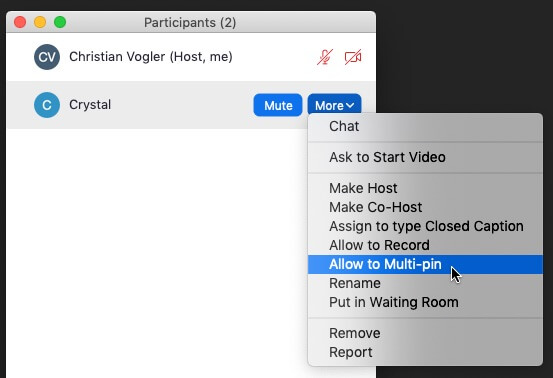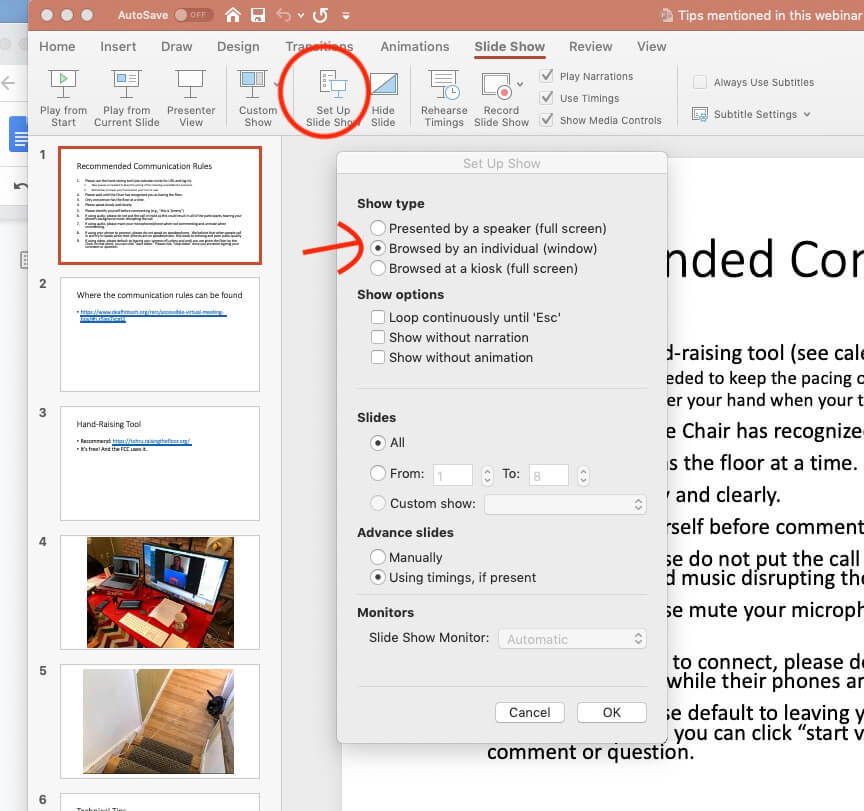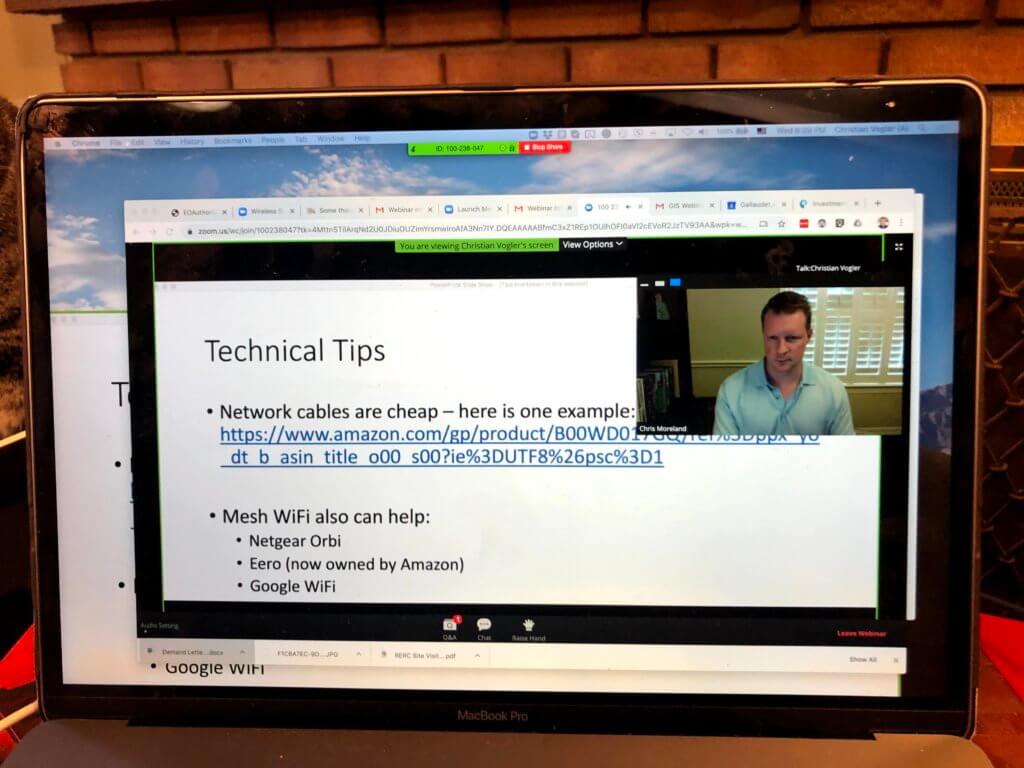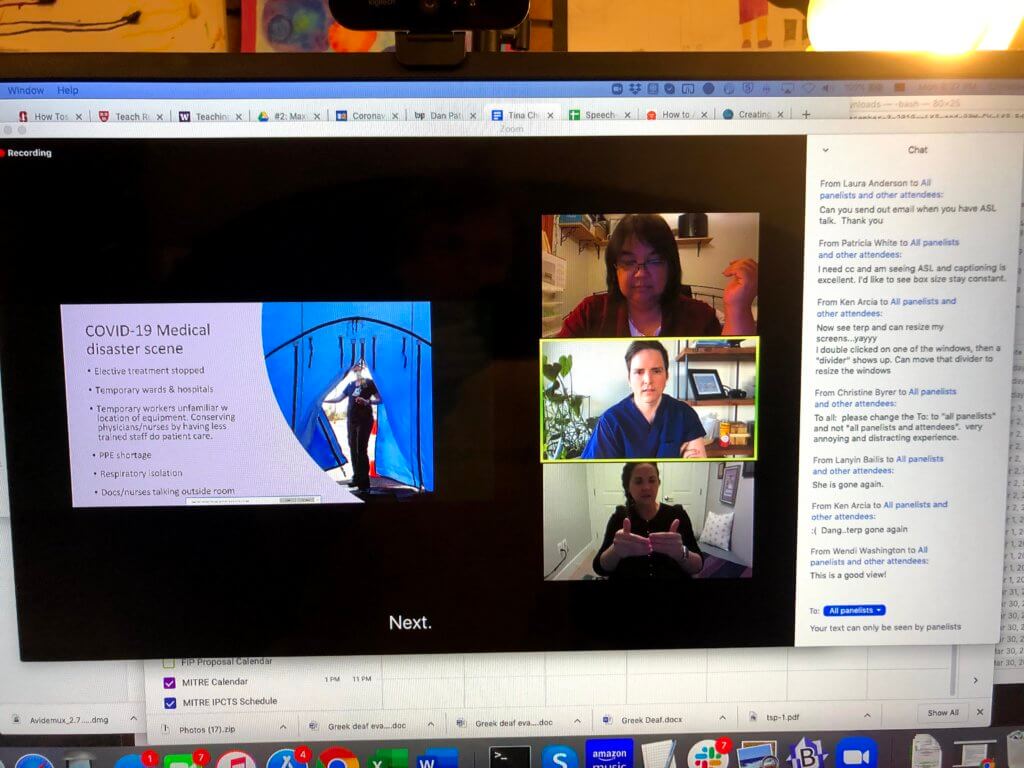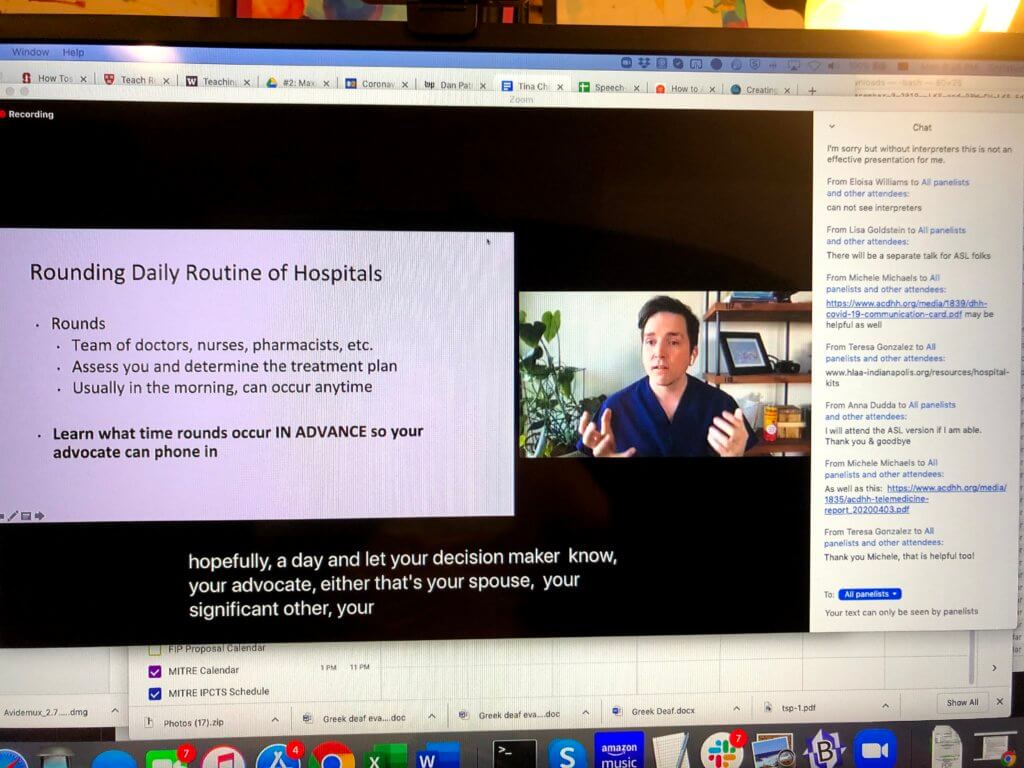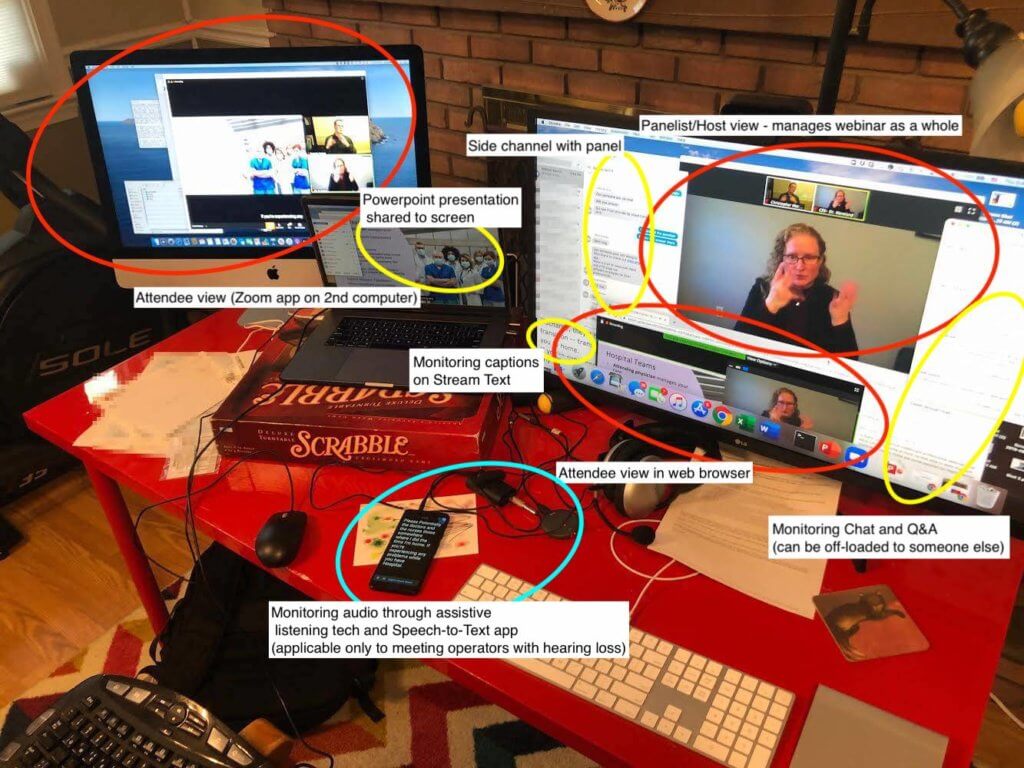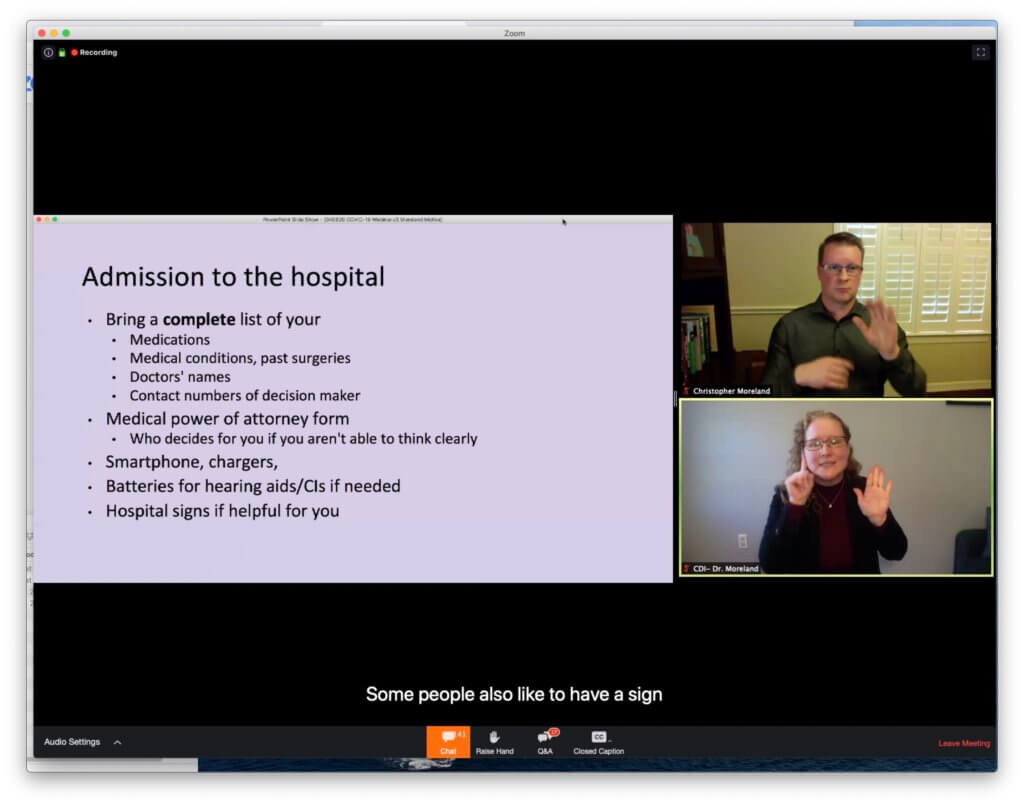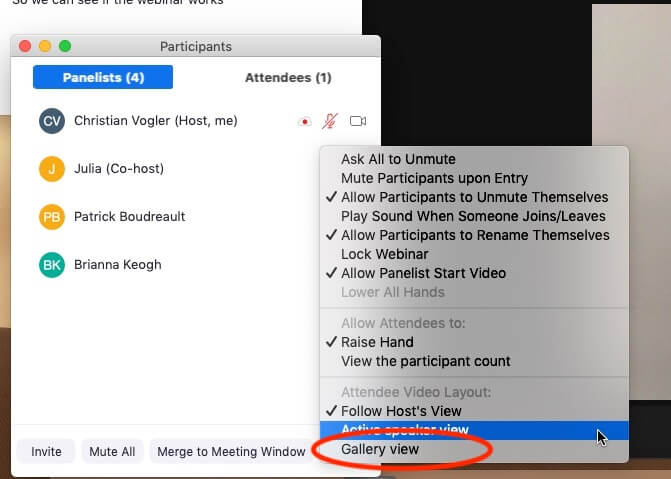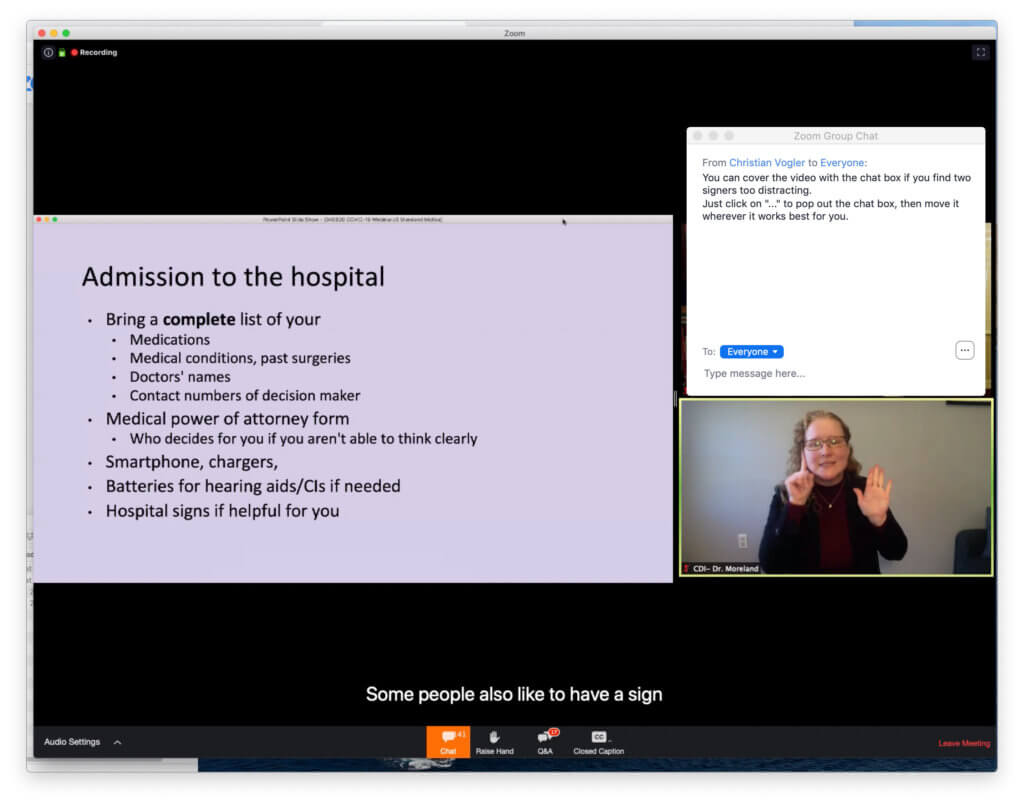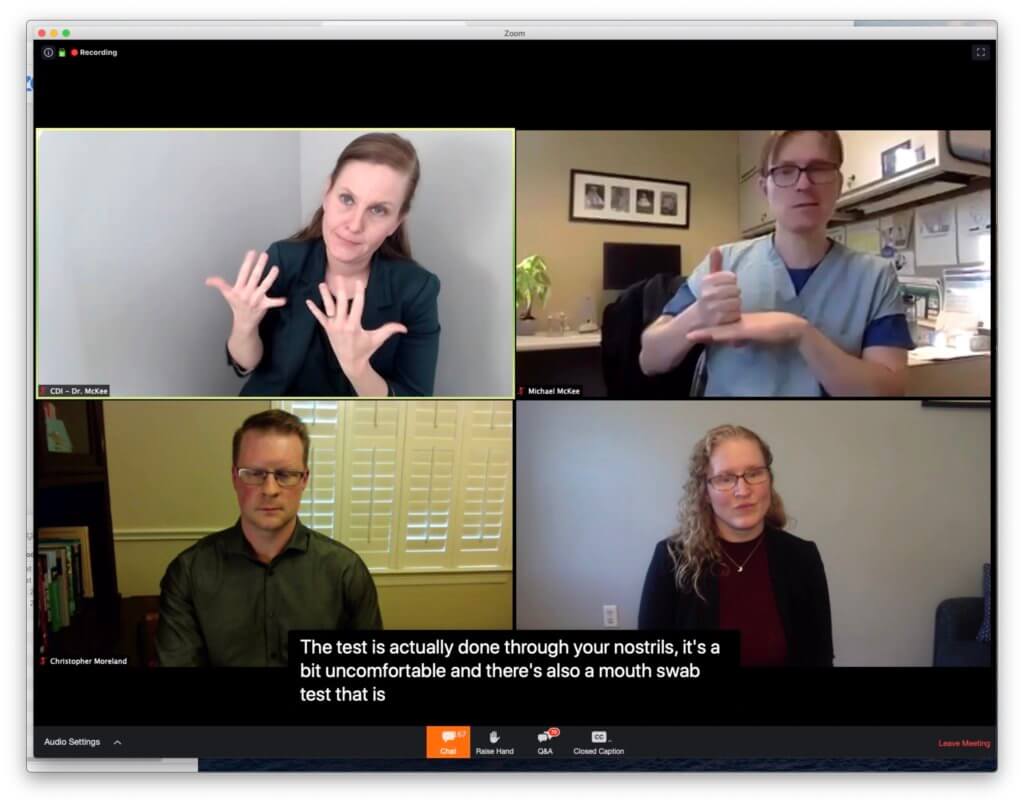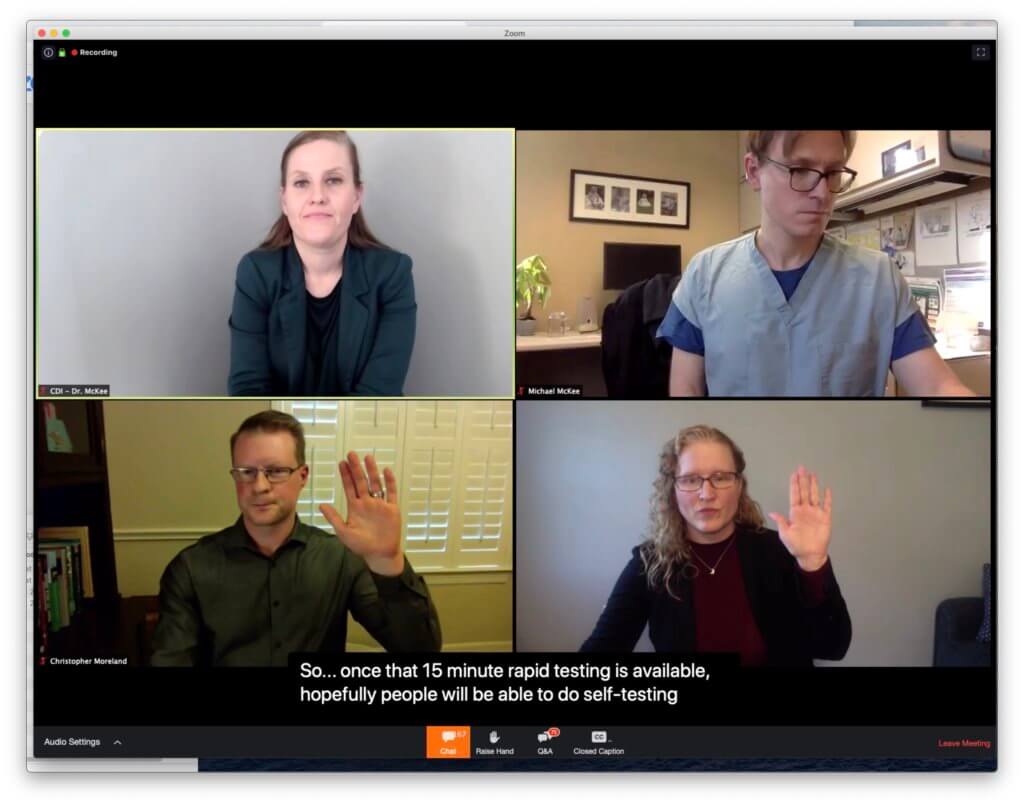October 25, 2020. This article (Word, PDF) provides a first-hand account of our experiences running Zoom webinars that are accessible to people who are deaf or hard of hearing. Although we expect that many of the concepts will apply to other webinar platforms, Zoom offers some specific advantages for reaching a deaf and hard of hearing population that we discuss in further detail below.
During the COVID-19 pandemic, webinars have become a critical tool for disseminating healthcare information in a timely manner, for providing workplace training, for engaging in lifelong learning, and more. Deaf and hard of hearing stakeholders are already at a disadvantage, compared to their hearing peers, where it comes to receiving information. More than ever, we must ensure that webinars are accessible to all, irrespective of disabilities.
This document presents general tips, our decision-making process and three case studies for webinars of increasing complexity, along with the lessons learned. Readers who would like to skip ahead to replicating successful setups may want to consult:
- Case Study 1 for running webinars with a regular Zoom license
- Case Study 3 for running webinars with a Zoom webinar license
Choosing Zoom as the Webinar Platform
Video conferencing tools are plentiful and enable institutions, organizations and individuals to connect virtually online regardless of their audience’s geographical location and communication preferences (e.g. phone vs video). While there are several large video conferencing tools to consider on the market, some are better tailored toward people who need visual access to information, such as sign language, cued language transliteration, and lip-reading. Zoom, a popular choice, has two key features:
- It allows for the option to host a larger audience with video based needs than most other available video conference tools, and
- you can watch on a web browser without having to install the app, which is an issue for some people with a locked-down work-provided laptop or people with lower computer literacy levels.
Combining multiple communication preferences can be challenging for any video conferencing platform. There are key limitations across multiple platforms that we will discuss in detail below.
Set-ups of Zoom for Webinars
Video-based webinars can function in two different modes: regular meetings, or webinar mode.
Regular Meeting Setup
Regular meetings are constrained by the maximum number of users that the Zoom license allows. It can be 100 (in the Basic and Pro plans), 300 (in the Business plans), or 1000+ (in the Enterprise plans). Regular meetings also are designed for interactive engagement between meeting participants on audio and video, with the potential to disrupt a presentation.
Using a regular meeting to run a webinar thus depends on the ability of attendees to follow video conferencing etiquette. The audience should understand that they must have their video off and audio muted if they are not presenting or communicating. While the hosts can exert control over the attendees’ video and audio functions, a large number of attendees can easily overwhelm the host’s ability to monitor this effectively. Note that these behaviors serve any audience well, whether deaf, hard of hearing, hearing, or mixed. As it often happens, accessibility accommodations for people with disabilities frequently benefit the group as a whole (e.g., better audio quality with fewer distractions by muting anyone except the speaker).
Although regular meetings rely on attendee etiquette, and put the onus on the host to monitor audio and video muting, they also provide a major advantage for accessibility. Compared to webinar mode, attendees have much more control over how they place their videos and slides from a screen share, if any. In the case of mixed spoken language and sign language meetings (e.g. presenter and ASL interpreter), this can be a key feature that can improve effective communication for different individuals attending the webinar, each with their own communication needs.
Webinar Mode Setup
Webinar mode requires a separate paid license above and beyond what regular Zoom plans offer. It tends to allow higher numbers of attendees (100-10,000 depending on license1), and also allows better host control over who can use audio and video, even if participants do not cooperate. In addition, Webinar modes allow for the inclusion of a Q&A feature in which the audience can use and ask questions outside of the chatbox.
The biggest downside of webinar mode is that attendees lose control over what videos to see and how they are placed. What is worse, the video placement depends on the behavior of the Zoom host (not co-host). Unless hosts are consciously aware of how their webinar settings and screen layout choices affect participants, there is a high risk for encountering major accessibility problems (more on this in Case Study 3).2 In all cases, webinar hosts should not count on videos being arranged in any particular order on the attendees’ screens.
The Zoom webinar panelists also have a completely different view of video and slides from the attendees, and may have no idea what regular attendees are seeing. We will discuss detailed anticipation and mitigation strategies in the case studies below (especially Case Study 3). These can be summed up in one key principle: Webinar organizers must monitor a session in attendee view in parallel and be responsive to problems discovered in the attendee view.
Web-based browser attendees pose their own challenges. As mentioned above, web browser support is important when an attendee is not permitted to install the Zoom app, or when the Zoom app does not launch properly from the web browser. Such attendees can at most see one video at the same time, either with or without slides (a characteristic picture of what that looks like can be found in the section on Case Study 1). Attendees on a smartphone or tablet also may have similar limitations with respect to viewing more than one video. Careful control by the host is required to spotlight the correct video; if more than one video needs to be seen at the same time, the host must make an accessibility trade-off decision, addressed in Case Study 2 below.
General Tips
It is advisable that the webinar organizers and panelists do a full technology run-through with the audio, video, screen sharing and captioning arrangements, as well as any communication side channels. This helps panelists familiarize themselves with the technology and the communication dynamics. It also brings to light any adjustments in meeting procedures that may need to be made. For example, in Case Study 1, we made adjustments to our spotlighting procedure as a result of the run-through. In Case Study 3, we made adjustments to the roles of monitoring the chat box and side channels. Note also that a run-through will minimize surprises, but not eliminate them entirely. The organizers and the meeting host should be prepared to think on their feet while the panelists run through their program.
Case Studies
Case Study 1: Deaf in Government Webinar
We had one deaf presenter using ASL, one hearing interpreter voicing the ASL to English, and one ASL-using moderator. Captioning was provided by Relay Conference Captioning (the federal real-time captioning service). Captioning was on a separate web page, not integrated into Zoom. In the meeting invite, we provided the captioning link to the attendees. We also copied and pasted the captioning link into the chat box multiple times at the beginning of the presentation. We encouraged attendees to pull up the captions on their phones or tablets, so as to save the space on their monitors for the video and slides. In light of the possibility that not every attendee may have had a second device available, we minimized the times when slides were shown on-screen to free up space.
The webinar was run as a regular Zoom meeting. The roles were:
- Host – behind the scenes, and only responsible for setting up the Zoom meeting. Video off.
- Presenter using ASL; made co-host in order to allow screen sharing and for back-up audio controls; Video on at all times
- Moderator using ASL; made co-host and responsible for reading out questions in the chat box; spotlighting videos; Video on during introduction and during Q&A, off during presentation
- ASL to English interpreter; attendee; only person with microphone on, but video off
While most attendees were good at joining with video off, we had a few stragglers who needed to be forced off by the co-hosts/moderator.
The moderator used spotlighting of the video to assign turns to herself and the presenter. We had a strict rule not to sign until we had received the spotlight. Note that spotlighting also results in a dialog asking whether one should unmute themselves. For sign language presenters/moderators the answer is No (or the option Later in the dialog box – which also can be selected through the Esc keyboard shortcut for convenience). If the presenter or moderator were to use spoken English, then this answer would change to Yes, and they would need to mute themselves at the end of their turn.
Spotlighting ensures that the video will be shown enlarged on attendee screens if they are watching in speaker view (useful for small screens), and it will ensure that the video is the one to show up on web-based attendees. In recent Zoom versions, it additionally will ensure that the video is streamed with the highest possible quality – there have been instances of non-spotlighted videos using lower resolutions and frame rates.
New: Note that with recent Zoom updates, it is now possible to spotlight multiple videos, although only the active speaker seems to receive the video quality bump. Participants can now pin multiple videos, as well. These new features allow for focusing on both the active speaker and the sign language interpreter (and/or cued language transliterator) of interest. If interpretation into more than one sign language is available during a webinar, the only fully accessible option is for participants to pin the relevant videos themselves, depending on what languages they use. Unfortunately, and inexplicably, the host must explicitly enable permission to multi-pin on a per-participant basis as shown in the screenshot below. This limitation reduces the overall scalability of this approach.
The presenter used screen sharing of a few slides sporadically, and switched in and out of screen sharing only when a slide needed to be shown. The majority of the webinar was in video mode without slides. As mentioned above, this has the advantage of giving more screen real estate to the signer, and also frees up space for viewing the web page with the captions on the same screen.
The slides were a PowerPoint deck, run from the native PowerPoint application, configured to display in a window, rather than full screen. Below is a picture of how to set this up on a Mac.
When ready to show the slides, the presenter simply clicked on the PowerPoint slide show start button, and they would show up in a window. This approach allows the presenter to share specifically the slide show window in Zoom, without having to worry what else shows up, or having the PowerPoint full screen mode interfere with the Zoom meeting.
If done correctly, this is approximately what shows up on a web browser-based attendee screen:
The video shown is the spotlighted one, and as mentioned before, the only one that some attendees will be able to see. Attendees who join via the Zoom app on a computer (not phone or tablet) have the option of selecting a side-by-side view, akin to the one shown in the pictures for Case Study 2.
Case Study 2: COVID-19 Webinar for Deaf/Hard of Hearing who Listen/Lip-Read/Speak
We had two deaf presenters speaking English, a team of two hearing English-to-ASL interpreters, and real-time captioning provided through both Zoom and StreamText. In the meeting invite, we provided the captioning link to the attendees. We also copied and pasted the captioning link into the chat box multiple times at the beginning of the presentation and encouraged them to watch the captions on the web page, as Zoom captions can often be harder to follow than StreamText. We also encouraged attendees to download the Zoom app, in order to be able to view more than one video at the same time. The webinar had specifically been planned for showing a speaker and an ASL interpreter on video simultaneously.3
This meeting was run in Zoom webinar mode, but with the Q&A feature disabled. Questions were typed into the chat box.
The roles were as follows:
- Host – IT support person of the organization hosting the Zoom webinar license; Video and audio off; sharing presentation slides from his screen; advancing slides on cue from the presenters.
- Presenter A – speaking English; Video on at all times; audio on when speaking
- Presenter B – speaking English; Video on at all times; audio on when speaking
- ASL interpreter A – translating English into ASL; Video on alternating with interpreter B
- ASL interpreter B; Video on alternating with interpreter A
- Captioner providing the captions to both Zoom and StreamText; video and audio off. The host (not co-host) must assign the responsibility for “typing captions” to this person within the panelist list.
All these roles must be made panelists.4 Panelists are able to see each other (if video is on), irrespective of what attendees see, and also can control audio and video functions for themselves. However, the panelist view is completely different from attendee views, and this can lead to problems if the attendee view is not monitored.
The ideal view for attendees looks like this:
From top to bottom, these are the videos of the inactive presenter, the currently active presenter speaking English, and the currently active English to ASL interpreter.5 Note that the order of the videos from top to bottom can be unpredictable for attendees, and presenters should not rely on any ordering. Additionally, at that time, we were unable to consistently reproduce this setting for the attendees in Zoom webinar mode, and attendees in webinar mode have no way to pick/control which videos to view on their own. The picture below shows what actually happened in this situation, where only one video was shown:
Having this situation can lead to an accessibility catch-22: people who listen and lip-read need the speaker video, but people who sign need the ASL interpreter view. At that time, there was no good solution to this scenario. The only viable decision was to spotlight the video that maximized accessibility for the greatest number of participants.
New: The host (not co-host) and the host’s Zoom settings control what videos appear for attendees – by default, if the host is in side-by-side mode with gallery view on, attendees will also see it. And conversely we have observed that by default, speaker view on the host’s computer will lead to only one video being visible to attendees. Recent Zoom updates have made the options more explicit, and they are covered in Case Study 3.
The panelists monitored questions and answers in the chat box. However, the chat box was flooded with questions, as well as unrelated comments, and mentions of technical issues. Keeping track of those questions that would need to be answered live on video became overwhelming for the panelists. In addition, the chat box also could overlap the captions seen by attendees, or otherwise block an important part of the video/slides.
In response to the lessons learned from this setup, we decided on a number of changes:
- Since Zoom chat box messages easily can be missed, the host and panelists need a side channel outside of Zoom to bring issues to one another’s attention, suggest steps to take, and suggest which questions/issues to respond to. iMessage is one such way, but any instant messaging application will work.
- The questions must be presented in the Q&A box – this allows the panelists to keep track of what has been answered.
- One to two dedicated panelists need to monitor the chat box and Q&A and attend to the questions there. These monitors must be distinct from the presenters, who have their hands full with just running the presentation. They can also answer certain questions in writing, leaving fewer that need to be answered live by the presenters.
- A dedicated person needs to spotlight the currently active video, again distinct from the presenters.
- The host needs to see what attendees see. Hence:
There is no substitute for one of the webinar panelists/hosts to run a second instance of Zoom on a different computer in attendee view and monitor what attendees are seeing, as well as monitoring the web browser view. The details are described in the next case study.
Case Study 3: COVID-19 Webinar for ASL users
We had two deaf presenters using ASL (non-native ASL users), a team of two English-to-ASL interpreters translating ASL to English voiceover, and real-time captioning of the voiceover provided through both Zoom and StreamText. Crucially we also had a team of two Certified Deaf Interpreters (CDIs) assigned. Their job was to translate the non-native ASL of the deaf presenters into clear native ASL accessible to a wide audience of deaf attendees with varying language skills and access to healthcare.
As in Case Study 2, in the meeting invite, we provided the captioning link to the attendees. We also copied and pasted the captioning link into the chat box multiple times at the beginning of the presentation and encouraged them to watch the captions on the web page, as Zoom captions can often be harder to follow than StreamText.6
This meeting was run in Zoom webinar mode, with Q&A enabled. Attendees were repeatedly encouraged to type their questions into the Q&A box.
The roles were as follows:
- Original Host – IT support person of company hosting the Zoom webinar license; Video and audio off; on standby for technical problems; responsible for starting the recording
- Meeting Operator – gets host privileges transferred from original host, then makes original host a co-host. Responsible for assigning panelist privileges, spotlighting of video, screen sharing of the slides, and monitoring and acting on the attendee view of slides and video. Will call out issues to other panelists in the side channel. Audio and Video off at all times.
- Presenter A – using non-native ASL; Video on when signing; audio off at all times.
- Presenter B – using non-native ASL; Video on when signing; audio off at all times.
- CDI A – shadowing Presenter A; her name in Zoom reflected Presenter A. Video on when Presenter A was signing; audio off at all times
- CDI B – shadowing Presenter B; her name in Zoom reflected Presenter B. Video on when Presenter B was signing; audio off at all times
- ASL to English interpreter A – Audio alternating with interpreter B; video off at all times
- ASL to English interpreter B – Audio alternating with interpreter A; video off at all times
- Captioner providing the captions to both Zoom and StreamText; video and audio off. The meeting operator must assign the responsibility for “typing captions” to this person within the panelist list.
- Chat box monitors – pull relevant problems and misdirected questions from the chat box. Ask participants to repeat misdirected questions in the Q&A box, and alert panelists to problems in the side channel. Answer technical questions in the chat box,7 unless they need to be escalated to the meeting operator in the side channel. Can be more than one; we had three in this case study, two of whom also acted as Subject Matter Experts described in the next point.
- Additional Subject Matter Experts – monitor Q&A box, presentations, and flag important topics for the presenters’ attention in the side channel. Can be more than one; we had two in this case study. Presenters A and B also jump in as backup Subject Matter Experts when their video is off and support the video-on presenter in providing draft responses to questions.
All these roles must be made panelists as in Case Study 2 – non-panelists cannot send audio and video, nor answer questions in the Q&A box.
The meeting operator is the key person who holds the webinar together. Because of the discrepancy between the panelist view in Zoom and the attendee view in Zoom, and the meeting operator is the only one who can control the video layout and see the immediate effect, the meeting operator has an outsized cognitive load to deal with. While the load is not insurmountable, future work should investigate if there is a way to split the responsibility across two people.
The image below shows the setup that the meeting operator used.
The attendees saw the following view:
The presenter is on top, and the Certified Deaf Interpreter (CDI) shadowing the presenter is on the bottom. Note that the CDI is spotlighted, which ensures that attendees who can see only one video at a time will see the CDI corresponding to the presenter. Although it is preferable to keep the CDI on top in order to ensure that the Zoom captions do not overlap with the video, Zoom has not offered this kind of granular control.
New: Recent Zoom versions allow the host (and no one else) to explicitly select what layout the attendees see. In the panelist/attendee list, the host can click on the “More” button at the bottom right and select one of three options in the popup menu: “Follow Host’s View,” “Active Speaker View,” and “Gallery View.”
The correct option is virtually always to select “Gallery View.” This will ensure that all the active panelist videos are visible to attendees who connect using the Zoom client. More importantly, it also insulates attendees from sudden changes that the host inadvertently may make to their own Zoom layout. With all this said, the meeting operator still needs to have an attendee view open to spot problems, even though they are less likely to occur with the gallery view setting.
Every time the presenters A and B switch, the meeting operator must spotlight the relevant CDI. Note also that the respective other presenter and CDI both have video off until they switch – this gives more screen real estate to the video.
Some participants commented that seeing both CDI and presenter signing at the same time was distracting. One workaround is for the attendee to pop out the chat box or Q&A box and cover the undesired video with it, as shown in the picture below.
After the presentation ended, during the Q&A session we decided to turn off the screen share of the slide show. This gave more space for the videos, and allowed us to have both presenters and both CDIs on screen. The meeting operator still was responsible for spotlighting the CDI shadowing the currently active signer. The attendee view looked like this:
Note how the CDI on the top left is currently spotlighted, shadowing the presenter on the top right. Note also that the CDIs are named after their paired presenters; for instance the naming of “CDI – Dr. McKee” reflects “Michael McKee” in the top row.
When the presenters switch turns, the presenter and his shadowing CDI raised their hands to make selecting the correct video to spotlight easier. For example, in the picture below, when switching, the bottom left presenter would raise his hand. The bottom right CDI would see this and mirror the hand raising. Then the meeting operator would spotlight the bottom right video.
Final Thoughts
It requires planning and forethought to make webinars accessible to people who are deaf or hard of hearing and rely on visual information for communication. The technology tools have been designed with hearing people in mind, and adapting them to the needs of the deaf and hard of hearing pushes the technology envelope.
With respect to Zoom, there may be further usability improvements available that we have not explored in this document. These include judicious switching between gallery view and speaker view, when to use side-by-side mode, educating attendees about pinning videos, and educating attendees about rearranging other elements of the Zoom user interface.
The keys to success are (1) extensive testing of the technology prior to running a webinar, and (2) having a set of “deaf or hard of hearing” eyes on the technology that can discover problems and have them corrected as they occur. Above all, it pays to be prepared for the unexpected.
Authors
Christian Vogler, Tina Childress, Michael McKee, Christopher Moreland, Robert Roth and Chad Ruffin
Questions? Feedback? Contact: virtualmeetings@deafhhtech.org
Further Reading
- DHH-RERC’s COVID-19 Technology Resources
- DHH-RERC’s Accessible Virtual Meetings Guide
- Tina Childress’s Captioning options for Videoconferencing and Learning Management Systems
Footnotes
- See the Zoom webinar licensing: https://zoom.us/webinar
- In particular, these experiences have been drawn from the webinars recorded at https://www.chadruffinmd.com/events/2020/4/6/covid-19-hearing-loss-amp-hospitalization and been refined through additional experience hosting webinars at Gallaudet University.
- Note that even though links to webinars are supposed to open in the Zoom app, if it is installed, this mechanism cannot be relied on. We have had instances of participants who were taken to the web page instead. Even if multiple videos are essential, organizers should consider if the webinar is still accessible and usable if only one video can be seen by attendees.
- We also intermittently made Presenter B a co-host, but this caused additional confusion and technical glitches with sharing slides and video arrangements. The roles of panelist and co-host should be kept separate in a large-scale webinar.
- Note that lighting is very variable on these videos shown – panelists and interpreters should take care that they are well-lit when organizing such webinars.
- Since this webinar was run, Zoom caption readability has improved greatly. However, having an external web page available (e.g. StreamText) still helps with reading back captions and catching up on anything that may have been missed while watching live.
- In some instances, participants had technical problems with the Q&A box, so sometimes the chat box monitors copied and pasted them. However, asking participants to do so themselves significantly cut down on chat box traffic by the halfway point of the webinar.

